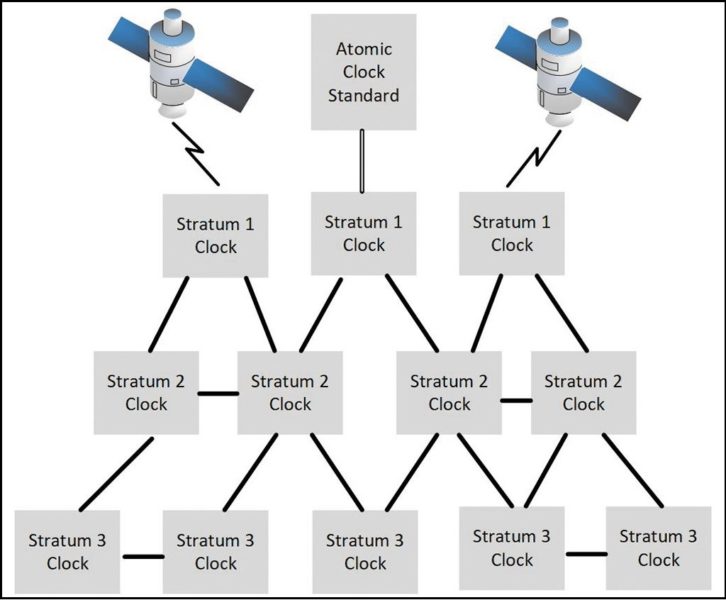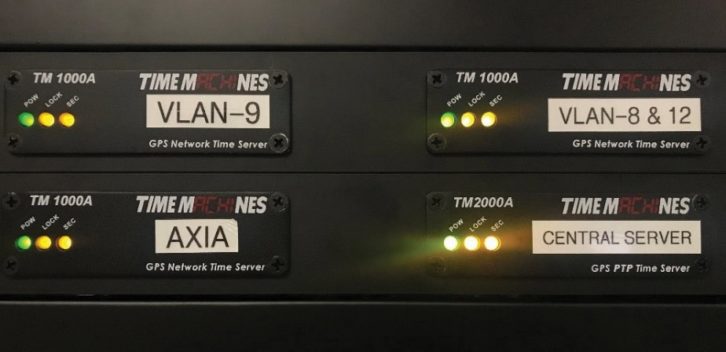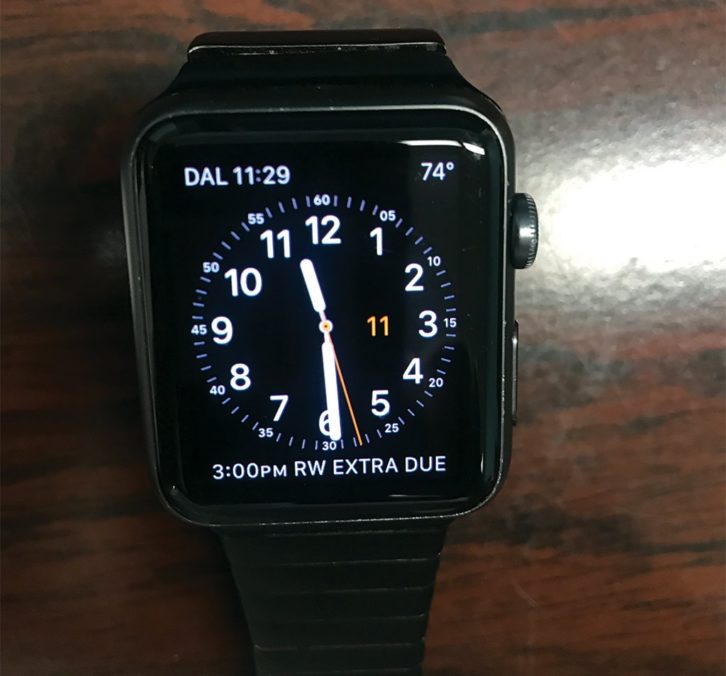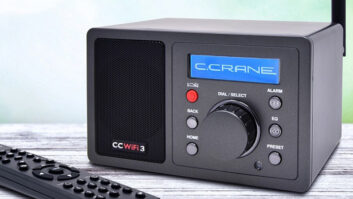Broadcast engineers are often found to be obsessed with time, likely because they are surrounded by time-critical tasks. Many a radio broadcast engineer has programmed an automation system schedule built around precise time program clocks that outlines and controls the content broadcast throughout the day. Precise in this case is defined to the second, with time synchronization often provided by a trusted network program content source.

And of course the all-familiar FCC-required legal station ID during the top of the hour window. The broadcast engineer in the joint radio and TV station likely has distributed SMPTE time code throughout the broadcast facility with the intention of locking video tape recordings to a precise and consistent time reference for editing purposes or simply synchronizing control room clocks.
Precise accuracy is defined to the sub-second or video frame rate. As the broadcast facility infrastructure, whether radio or TV, has migrated to an Information Technology (IT) environment and infrastructure, precise time references such as the Internet Protocol (IP), Network Time Protocol (NTP) and the Precise Time Protocol (PTP) have emerged. Precise in terms of accuracy to 1 mS for NTP.
Time references existed long before the first broadcast stations. The sun might be considered our first time reference standard for the local community, with 12 noon defined as occurring when the sun was directly overhead.
Many communities relied on local time synchronization provided by a dominant community member. I grew up in a small east Texas town where you could count on the local “steam whistle” from the refinery to sound at 8 a.m., 12 noon and 5 p.m.
RAILROAD TIME
In the mid-1860s, Western Union utilized its nationwide telegraph system to distribute time signaling from the U.S. Navy Observatory (USNO) in Washington, D.C. The observatory used precise celestial optical observation to establish a time standard reference. This same time reference was first used to synchronize clocks in the railroad system, bringing some order to what was often described as a continuous state of confusion between “railroad” time and the local community time. The nationwide telegraph system became dedicated for time distribution just before the top of each hour.
The establishment of 24 worldwide time zones setting our familiar time zones with each referenced the Greenwich Mean Time (GMT) was stated as “humanizing time.”
In some communities, one could find Western Union synchronized clocks in corporate offices, schools, banks and public venues that were connected by “clock loop circuits,” providing synchronization at the top of each hour. The time synchronization signal consisted of an established sequence of 1-click-per-second clicks of the telegraph sounder across the nationwide telegraph system a few seconds before the hour. After a pause, the final click or “mark” signal originated a local reset signal to drive a solenoid in the clock, resetting the clock time to the current top of the hour.
History indicates that this fee-based nationwide standardized clock time system remained in service into the ’70s but faded away as the telegraph as a delivery medium and Western Union faded away. Today, a Western Union railroad clock manufactured by the Self Winding Clock Company is considered a cherished technology collector’s item by many.
AT THE TONE, THE TIME IS…
And of course the broadcast engineer is familiar with the precise time and frequency information broadcast by WWV in Fort Collins, Colorado and WWVH in Kauai, Hawaii on a variety of frequencies ranging from 2.5, 5, 10, 15 and 20 MHz utilizing 1/2-wave antennas. These time and frequency reference broadcasts provided by the National Institute of Standards and Technology (NIST) utilize multiple cesium atomic clocks for precise time and frequency accuracy. Many a broadcast engineer has utilized the precise 10 MHz WWV broadcast as a frequency reference to calibrate or verify their local frequency counter.
The legacy broadcast engineer may have had a master clock utilizing a WWV or WWVH receiver as the time reference. The military Inter-Range Instrumentation Group (IRIG) type H time code format broadcast by WWV or WWVH was the only openly available time reference standard before Global Navigation Satellite Systems (GNSS) were available. WWVB, also in Colorado and adjacent to the WWV stations, broadcasts a 1 bit-per-second time code on 60 kHz that is responsible for keeping an estimated 50,000,000 consumer timepieces automatically synchronized. That $19.95 “atomic” clock on your kitchen wall relies on WWVB for its time synchronization.
Today, a GNSS-based time master clock is an integral component of the broadcast technical plant. The Global Positioning System (GPS) satellite constellation operated by the United States Department of Defense (DoD) is one of several worldwide GNSS systems in operation. GPS utilizes multiple Cesium Beam or Hydrogen Maser atomic clock references provided by the USNO.
Whereas the system was primarily developed for navigation applications, the system can be used to provide a precise reference to a disciplined oscillator in the local master clocks by reception of several GPS satellite time signals providing facility time and system timing information.
GPS system accuracy is often quoted in terms of location accuracy such as a minimum of 4 meters for civilian applications which receive a coarse-acquisition (C/A) code on 1575.42 MHz. Military GPS (referred to as PPS) uses the civilian frequency plus a second signal on 1227.60 MHz to reduce radio path degradation caused by atmospheric disturbances. With regards to a time reference, accurate time information can be determined to the microsecond level.
The GPS-based master clock references in a broadcast facility are capable of supplying time references in several formats ranging from the SMPTE time code, to NTP and PTP, and to several General Purpose Output (GPO) interfaces. These GPO output interfaces are typically Transistor-Transistor-Logic (TTL) based signals in formats including one pulse per second (1PPS) and top-of-hour (TOH) pulse.
Facility distribution allows a single reference to supply time information to a variety of devices throughout the facility in lieu of each device containing its own time standard based reference. In addition, a 10 MHz frequency reference is often provided by these references and is useful to check calibration of the stations frequency-measuring devices.
The 1PPS and TOH outputs have been used to synchronize other devices in the broadcast plant such as early automation systems. The GPS-based master clocks provide time in the Coordinated Universal Time (UTC) format. UTC may also be referred to as solar time.
SMPTE time code, known as SMPTE 12M-2, can be found in two formats: Longitudinal (LTC) or Vertical-Interval (VITC). Time is presented in the format of hours:minutes:seconds:frame or HH:MM:SS:FF and is represented by 32-bit binary coded decimal (BCD) number identifying an individual frame of video.
In order to correct for the 29.97 frames per second rate of color NTSC, drop-frame (DF) time code is commonly used. It is typically represented as HH;MM;SS;FF with the semicolon indicating the drop-frame mode. The name is often misleading, as no frames of video are actually dropped. Instead a few time codes are dropped in order to match up the timecode with clock time.
The broadcast facility today likely relies on NTP for time synchronization among a diversity of IP-based host devices. NTP is defined as time synchronization over a packet-switched network or today’s common IP network. Now in version 4 (NTPv4) as defined by Internet Engineering Task Force (IETF), Request for Comments (RFC) 5905 provides accuracy to 1 mS. NTP is considered one of the core IP protocols and utilizes TCP/UDP port 123 as assigned by the Internet Assigned Numbers Authority (IANA) and an IPv4 multicast address of 224.0.1.1.
A NEW AND ECONOMICAL OPTION
For many, NTP is an excellent (and now economically implemented) approach to time sync devices in the broadcast plant, such as an automation system components, network content sources, the control room clock and of course all IT-oriented devices. Development of improvements continues today with enhancements specifically in the area of network security.
NTP was developed as a client-server application utilizing a complex algorithm to determine a precise time reference accounting for variable packet network time delays. The client on a host device calculates a time offset and the round-trip-delay from one or more time reference sources.
A peer-to-peer mode is also supported where a peer node can consider another peer node as a time reference.
The NTP client utilizes the familiar Bellman-Ford shortest path spanning tree algorithm to calculate and in turn minimize the delay to the reference time server. NTP clients have been developed for all mainstream computer operating systems, and thus are available for a wide range of host devices. In the Unix/Linux environment, the client is implemented as the daemon “ntpd,” and as a service in the Windows operating system. The Simple Network Time Protocol (SNTP) defined by RFC 2030 was developed as a simplified version of NTP and is often found in embedded systems where less demanding time synchronization is required.
NTP is based upon a hierarchical or layered scheme of time references described as a Stratum level ranging from 1–16. A Stratum 0 clock is defined as a high-precision reference clock and is not connected to the network as it only serves as a reference. It is simply a high-precision reference standard.
A Stratum 1 clock is directly connected (wired or RF path) to a Stratum 0 reference and is in turn utilized to synchronize lower level clocks. A Stratum 16 clock is considered an unsynchronized clock as is often a clock that has lost network connectivity to its reference source.
The Stratum n description refers to the device distance from the reference source rather than an indication of an actual time accuracy. In reality a Stratum 3 clock may be the most accurate, as this level can be synchronized with multiple Stratum 2 clocks which are referenced to multiple Stratum 1 clocks, as shown in Fig. 1.

NTP utilizes the Unix time epoch. The Unix epoch, also known as POSIX time or Unix time, is based upon the number of seconds occurring since January 1, 1970 as each day consists as 86,400 seconds. Unix time is represented by a signed 32-bit numerical integer string such as “1560862759.”
The Internet provides ample time conversion utilities. The current Unix integer time string can be found at https://time.is/Unix_time_now. However, NTP utilizes a modified method of storing the time integer value. Sixty-four bits are used to create an NTP timestamp by assigning 32 bits for the second storage and 32 bits for the fractional second.
A DIFFERENT “Y2K” BUG?
Looking ahead, the use of a signed 32-bit time storage unit creates a problem upon reaching Jan. 19, 2038, as an integer overflow occurs and the time becomes a negative integer and begins counting backwards. This often is referred to as the “Y2K38” problem. Most if not all operating systems have corrected for this problem by adopting a 64-bit storage registers.
NTP has a similar roll-over issue occurring in February 2036. However, the impact is not felt to be as severe since NTP time determination is based upon time-stamp differences rather than an absolute value. Future NTP versions will likely extend the timestamp value to 128-bits. Today, it is not clear as to what the final recommended solution(s) may be.
Yet another enhancement to NTP is PTP. Maybe not found in the radio station environment today, it is worth being aware of. PTP is defined under the Institute of Electrical and Electronic Engineers (IEEE) 1588 standard now implemented in version 2 or IEEE-1588-2008. PTP is master-slave architecture similar to NTP, but provides accuracy in the sub-second range.
IEEE 1588 is used in utilized in network applications where accuracy is required beyond the capabilities of NTP such as industrial automation and financial transaction markets. It has become commonplace in IP-based TV networks such as the Society of Motion Picture & Television Engineers (SMPTE) ST-2110 standard. PTP is designed for local area networks requiring accuracy in the sub-nanosecond range.
PTP utilizes a synchronization master as the root time reference referred to as the “grandmaster” clock. The grandmaster derives its reference from a Stratum 0 source such as the GPS satellite constellation. A “slave” clock in turn derives a time reference from the grandmaster. Boundary clocks may be present, which in turn relay time information to other segments of a network.
The PTP standard utilizes UDP messages to convey time reference information between devices on the network with IPv4 multicast addresses 224.0.0.129 and 224.0.0.107 registered for message exchange. Master clocks can be obtained that serve as both NTP and PTP time references.
A common challenge in many broadcast facilities is providing NTP time services across multiple isolated IP networks or subnets in the facility. These individual isolated networks are often built with Virtual Local Area Network (VLAN) segments and utilize private IP address space. The multiple subnets are used to segment or isolate critical broadcast network functions into layers or zones.
NTP time information can be shared across multiple networks by a sometimes elaborate means of static Network Address Translation (NAT) and Access Control Lists (ACL) in a Layer 3 router to control inter-subnet interoperability from a cybersecurity standpoint. The use of an ACL allows only NTP packets to be exchanged between the individual subnets.
I have found that a better approach is to use an individual NTP time server for each network subnet. This approach is now feasible from an economic standpoint as a NTP server can be purchased for less than $300 such as the TimeMachines TM1000A GPS NTP Network Time Server. A single outdoor GPS antenna and multi-port signal splitter provide a GPS antenna connection to each time server. The more industrious engineer can roll his own time server with an OEM GPS receiver, a Raspberry Pi, and some open-source software. Each time server is configured for each network subnet required such as shown in Fig. 2.

No wonder the broadcast engineer is often obsessed with time when his or her day is often defined in terms of seconds, frames, milliseconds and even microseconds. The broadcast engineer’s Apple “iWatch” as shown in Fig. 3 is considered a Stratum 2 reference, as Apple maintains a network of fifteen (15) Stratum 1 time servers worldwide.

By the way, you did ask what time it is. This column was submitted to the editor at precisely 1568613600 prior to the deadline of 1569412740.
Wayne M. Pecena, CPBE, 8-VSB, AMD, DRB, CBNE is associate director, Educational Broadcast Services at Texas A&M University and director of engineering at KAMU TV and FM. He also is president of the Society of Broadcast Engineers and a past recipient of the Radio World Excellence in Engineering Award.







